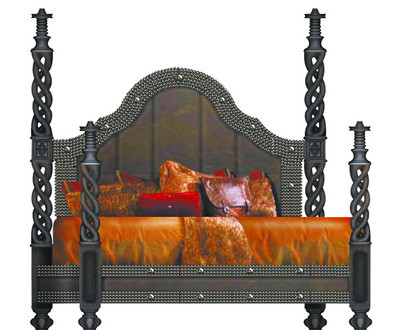HOW THE WEST WAS FURNISHED

Just as it took decades for pioneers to discover the West, the Museum of New Mexico continues to explore the unique heritage of Santa Fe through its home furnishings collection.
The collection, which includes wood furniture, upholstery, lighting, bedding and rugs, continued its own Westward Expansion earlier this year with several introductions at the home furnishings trade show at the World Market Center Las Vegas.
Launched in July of last year, the collection taps into the state’s cultural heritage, said Pamela Kelly, director of licensing for the Museum of New Mexico Foundation.
Prime examples are the Manderfield and Don Miguel beds by T.S. Berry.
Named after a wealthy East Coast gentleman from Pennsylvania, the Manderfield bed is modeled after an ornately carved bed that traveled West on a covered wagon with William Manderfield, who arrived in Santa Fe in 1863 and found a job with the weekly newspaper, the Santa Fe New Mexican. A year later he became co-owner and editor of the paper, a position he held until 1881.
The grand proportions and detailed carving of the original bed are preserved with T.S. Berry’s version that has an elegant crown framing the headboard and veneer panels of hand-matched walnut.
“Manderfield married a local woman,” Kelly said. “Her Spanish pieces all worked so well with his furniture. Out of necessity, they married their two styles. It shows today how we can mix these two styles.”
The Don Miguel bed expands on a popular design from the collection’s debut. Inspired by a small Moorish or African chair, the poster bed is highlighted by 5,000 individually placed, hand-hammered nailheads, said Scott Jensen, designer and general merchandise manager for T.S. Berry. It also features barley twist posts on the foot and head boards, which can be shortened by just using the finials.
According to Kelly, the pattern of the nailheads and curve of the headboard is unique to 15th and 16th century Spain and emblematic of the blending of specific Moorish and Spanish traditions.
The original chair was purchased in Spain and brought to Santa Fe. It was owned by Miguel Otero, who served as a territorial governor, and donated to the museum by his daughters.
Made of alder solids, the bed has a slightly time-worn, relaxed look achieved by combining a subtle use of grooves, gouges and indentations and a final cracked glazed top coat.
Although more stereotypical of the Old West, the T.S. Berry’s El Monte game table was created to honor Doña Maria Gertrudis Barcelo, or La Tules, and her well-known gaming establishment.
The table’s main design element is based on ornate balustrades that were often seen in saloons. Jensen said the “rustic” design evokes images of a Western dance hall, complete with a piano player. The eight-sided table is reversible, with a game surface on one side and a wooden starburst on the other.
The accompanying chairs have a parlor feel and are on casters.
In addition to matching Manderfield and El Monte sofas and ottomans, collection partner King Hickory created the Pullman sofa, Florence chair and Lion’s Paw leather chair.
Kelly said the Pullman sofa was named after George Pullman, who invented the Pullman sleeping car in 1857. The sofa has a deep seat, high curved leather back and wood stretcher and arm panels.
It pairs well with the Florence chair, which pays tribute to Florence Dibell Barlett, founder of the Museum of International Folk Art. After visiting the city, Barlett purchased a 70-acre ranch, where she spent many evenings in her favorite chair watching the sun set over the Western landscape. Upon her death in 1953, her chair was donated to the museum.
Barlett also donated a hand-crafted 17th century dining chair that she purchased in southern Norway during one of her many trips to Scandinavia. The original chair had a leather seat and similar crown motif on the back and stretcher, along with lion’s paw feet. Because of its age and ornamentation, it is thought to have belonged to a royal household in Norway, Kelly said.
Many of the original pieces that inspired the furnishings and accessories featured in the collection can be found in the divisional museums that comprise the Museum of New Mexico. This year marks the museum’s centennial. The celebration includes 100 special exhibits and events throughout the state, including the Memorial Day opening of the New Mexico History Museum.
Pieces from the collection, along with more information is available at the Web site www.shopmuseum.com.